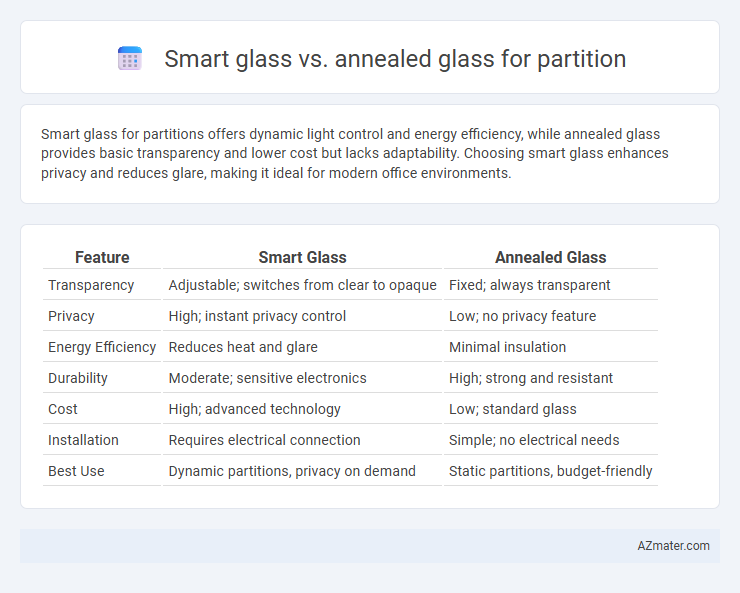Smart glass for partitions offers dynamic light control and energy efficiency, while annealed glass provides basic transparency and lower cost but lacks adaptability. Choosing smart glass enhances privacy and reduces glare, making it ideal for modern office environments.
Table of Comparison
| Feature | Smart Glass | Annealed Glass |
|---|---|---|
| Transparency | Adjustable; switches from clear to opaque | Fixed; always transparent |
| Privacy | High; instant privacy control | Low; no privacy feature |
| Energy Efficiency | Reduces heat and glare | Minimal insulation |
| Durability | Moderate; sensitive electronics | High; strong and resistant |
| Cost | High; advanced technology | Low; standard glass |
| Installation | Requires electrical connection | Simple; no electrical needs |
| Best Use | Dynamic partitions, privacy on demand | Static partitions, budget-friendly |
Introduction: Understanding Smart Glass and Annealed Glass
Smart glass utilizes advanced technology to change transparency and control light, enhancing privacy and energy efficiency in partitions. Annealed glass is a standard, non-tempered glass known for its clarity and cost-effectiveness but lacks dynamic light control features. Comparing smart glass with annealed glass highlights significant differences in functionality, durability, and applications in modern partition design.
What is Smart Glass? Definition and Features
Smart glass, also known as switchable glass, is an innovative material that changes its light transmission properties when electrically activated, allowing for instant transformation between transparent and opaque states. It offers features like privacy on demand, UV protection, energy efficiency, and enhanced aesthetic appeal, making it ideal for partitions in modern offices and homes. Unlike annealed glass, which is simply standard heated and cooled glass for safety and strength, smart glass provides dynamic control over light and visibility, promoting flexible space management.
What is Annealed Glass? Definition and Properties
Annealed glass is a type of glass that is slowly cooled after manufacturing to relieve internal stresses, resulting in improved stability and durability. It offers high clarity and is easy to cut and shape, making it a cost-effective option for partitions. However, it is more prone to breakage and shattering into large, sharp pieces compared to stronger alternatives like tempered or smart glass.
Comparison of Light Control Capabilities
Smart glass offers dynamic light control by switching from transparent to opaque states using electrical stimuli, enabling precise modulation of privacy and natural light. Annealed glass, being standard clear glass, lacks light modulation capabilities and allows unfiltered natural light to pass through, providing no control over glare or privacy. The advanced technology in smart glass significantly enhances energy efficiency and occupant comfort compared to the fixed transparency of annealed glass in partition applications.
Privacy and Security Differences
Smart glass offers dynamic privacy control by switching between transparent and opaque states, enhancing confidentiality in office partitions without sacrificing natural light. Annealed glass, being static and clear, provides minimal privacy and requires additional treatments like frosting or films to improve security and opacity. The adaptive opacity of smart glass significantly reduces visual access risks, making it a superior choice for environments demanding flexible privacy and heightened security.
Energy Efficiency and Insulation
Smart glass enhances energy efficiency in partitions by actively controlling light transmission and reducing heat gain, leading to lower HVAC costs. Annealed glass, while less expensive, offers minimal insulation and does not contribute to temperature regulation or solar control. The dynamic thermal performance of smart glass significantly outperforms the static properties of annealed glass in maintaining consistent indoor temperatures.
Durability and Maintenance Requirements
Smart glass offers enhanced durability compared to annealed glass due to its laminated or tempered construction, which resists impacts and reduces the risk of shattering, making it ideal for high-traffic partition applications. Maintenance requirements for smart glass are relatively low, with surface cleaning being the primary need, although electronic components demand occasional servicing to ensure optimal performance. Annealed glass, while more prone to breakage under stress, requires straightforward maintenance but lacks the advanced durability and noise reduction benefits offered by smart glass partitions.
Aesthetic and Design Flexibility
Smart glass offers unparalleled aesthetic versatility with its ability to switch between transparent and opaque states, enabling dynamic privacy and style options for partitions in modern interiors. Annealed glass features a classic, clear appearance that allows for maximum light transmission but lacks the adaptive design flexibility found in smart glass. Designers favor smart glass for innovative environments requiring customizable ambiance, while annealed glass suits traditional settings prioritizing simplicity and cost-effectiveness.
Cost Comparison: Installation and Long-term Value
Smart glass typically involves higher installation costs due to its advanced technology and electrical components, whereas annealed glass offers a more budget-friendly upfront price. Over time, smart glass may provide greater long-term value by reducing energy costs and enhancing privacy without additional treatments, while annealed glass might incur recurring expenses for window films or blinds. Factoring in maintenance and energy efficiency, smart glass can be a cost-effective investment despite its initial price premium.
Choosing the Right Glass for Your Partition Needs
Smart glass offers dynamic opacity control, enhancing privacy and light management in office and residential partitions, while annealed glass provides a cost-effective, clear option with high durability but no privacy features. Selecting the right partition glass depends on factors such as privacy requirements, budget constraints, and desired aesthetic appeal. Smart glass suits environments needing adjustable transparency and energy efficiency, whereas annealed glass is ideal for straightforward, affordable partitions without the need for light modulation.

Infographic: Smart glass vs Annealed glass for Partition
 azmater.com
azmater.com